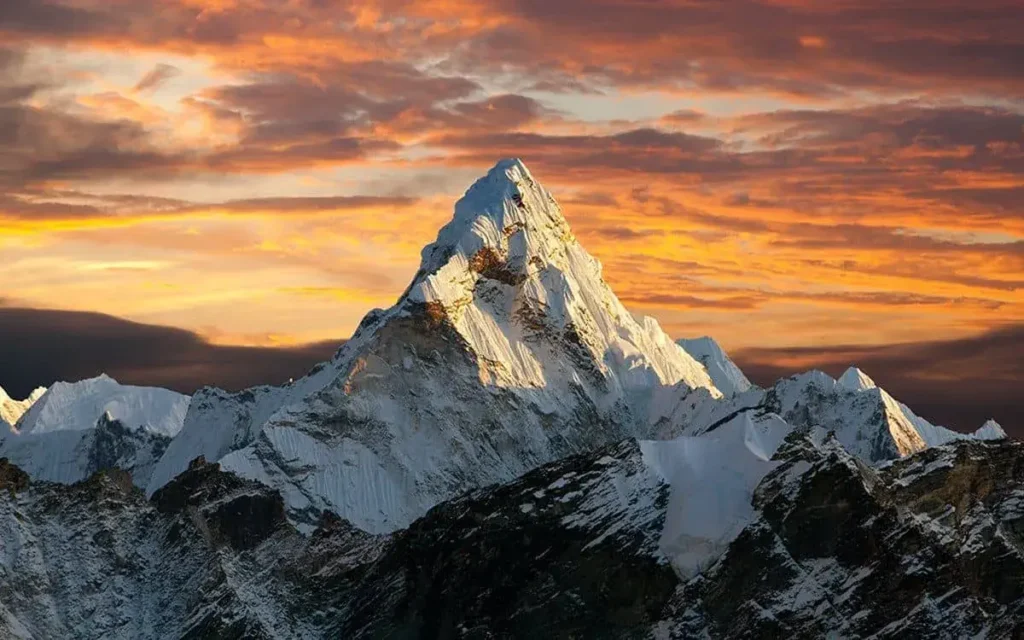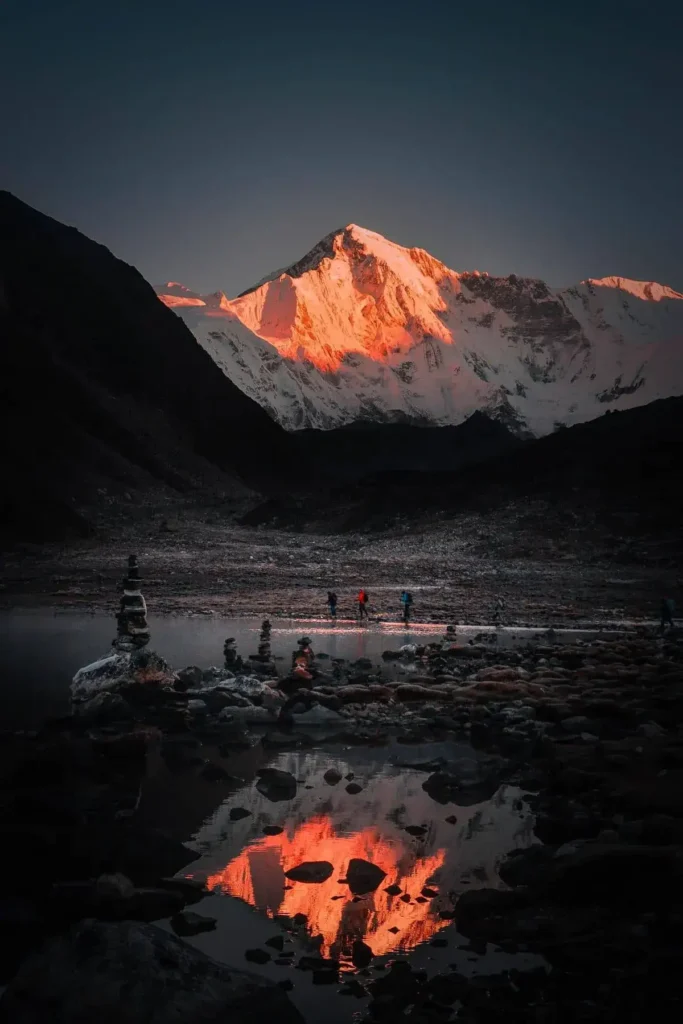
The mountain represented height, greatness, strength, and beauty of the nature throughout the world hence the mountains fascinated many people. These wonderful giants depict the tallest human climbable mountains from the higher Himalayan area to the lower Antarctica: all are fascinating, all are test of person’s physical and endurance strengths in exploration. This article will bring into focus the tallest mountains in the world and shed light on how their towering structures, complicated terrains and interesting geographical formation and the thrilling endeavors of climbing and exploration happening on them. If you love climbing, geography or just have been wondering how the territories we live on formed – welcome! Let us climb magnificent giants together!
Table of Contents
The Top 10 Highest Mountains in the World
1. Mount Everest

Mount Everest, the highest mountain in the World, stands at 8,848.86m (29,031.7feet).8,848.86 meters (29,031.7 feet). Nepal and Tibet’s bordering peak attracts thousands of climbers each year, albeit it being one of the world’s most dangerous to climb due to its altitude. Originally climbed in 1953 by Sir Edmund Hillary from New Zealand and Sherpa Tenzing Norgay, Everest’s height and celebrity status make it the most iconic mountain in the World. Climbers endure low oxygen levels, very cold environment, changing weather conditions and a constant threat of an avalanche. Nevertheless, there are dangers that persist to attract what one may call ‘men and women of the world’ to be on the summit of Everest.
2. K2 (Mount Godwin-Austen)2Kangchenjunga

Location: Pakistan/China
It is K2 at 8,611 meters (28,251 feet), on the border between Pakistan and China. Typically considered to be the most challenging mountain to climb, K2 has steep climbs, technicality, and constant avalanches. First climbed in 1954 by Italians Achille Compagnoni and Lino Lacedelli, K2 is considerably more dangerous than Everest, thanks to its challenging climbing profile and unstable climate. Its seclusion and the fact that it is so hard to climb keep all but the most experienced climbers away. K2 is climbed through the strength, skills and brainpower.
3. Kangchenjunga

Location: Nepal/India
Kangchenjunga, which rises to a total height of 8,586 meters (28,169 ft) and is Way third most considerable mountain in the world is located in Nepal-India border. Translated from the Tibetan it is known as ‘Phugbrang Five Treasures of the Snow’ due to five major spires on the mountain. Kangchenjunga, the third highest mountain in the world was climbed for the first time in 1955 by Joe Brown and George Band but its is believed to be the god’s house by the local people. Despite it ranking high in terms of difficulty it is a little less popular as ever and K2 or any other peak mountain for the reason of geographical isolation, tough terrains and taboos against such attempts for cultural taboo. This is an aspect that has made climbers struggle alot with the ridges, icy nature of the mountain and weather. The fact that it has aesthetic and artistic value to it and important in the culture of climbers makes Kangchenjunga a very sacred mountain.
4. Lhotse

Location: Nepal/China (Tibet)
Lhotse with height of 8,516m (27,940ft) is rated 4th tallest Mountain in the world and is situated close to Mount Everest. Even though, it rises from similar point as Everest, its slopes are steep and technical ridges make it more of a challenge. First ascended in 1956, Lhotse is still classified by climbers more trying than Everest, particularly because of the steep, rocky faces of the mountain. Despite being not very popular, Lhotse is challenging to climb due to its geographical location, and technical climbing involved in the endeavor.
5. Makalu

Location: Nepal/China (Tibet)
Makalu is the fifth highest peak in the world at 8485meters/27838feet in the Mahalangur range just fourteen kilometers from the main Himalayan range at Everest. Due to its steep gullies and stormy weather, it is not as often attempted as the other eight thousanders, being relatively difficult to summit anyway. Makalu, was first climbed by Lionel Terray and Jean Couzy in 1955 and even today it is not much of a popular climbing destination because of its geographical location and technicalities involved. Climbers are tested by its very long and intricate approach and steep ridges giving even veteran climbers a hard time.
6. Cho Oyu

Location: Nepal/China (Tibet)
Cho Oyu which is on the border of Nepal and Tibet has a height of 8,188 meters or 26,864 feet. Baruntse has been considered to belong to “easier” 8000m peaks to climb and thus attracts aspiring summiters for the first time. But unlike Kangchenjunga, whose seemingly easier routes can still prove deadly at moves at such great height, Cho Oyu’s relatively easier peaks and easier accessibility sets many climbers its way despite the altitude and the risks it poses. Cho Oyu, first climbed in 1954 by Herbert Tichy with Joseph Jöchler and Pasang Dawa Lama, holds the relatively high success rate among 8,000 metermassifs. But it is still cold and difficult at the higher elevations; and there is still the objective to achieve.
7. Dhaulagiri I

Location: Nepal
Dhaulagiri I is the seventh highest mountain, 8,167 meters (26,795 feet) and is located in Nepal. It is characterized by longest ridges, steep slopes, and has developed a weather contingency problems. First climbed in 1960, by climbing party of Kurt Diemberger, Peter Diener and others Dhaulagiri is very isolated and difficult to climb. It has a long and difficult approach path, sits in a highly fraught zone for avalanches and reaches a very high altitude. Despite these problems it remains one of the most attractive mountains for climbers who have various kind of mountaineering skills.
8. Manaslu

Location: Nepal
Manaslu is also referred to as the Kangari Majestic Mountain of the Spirit and rises to 8,163m (26,781ft), and is the eighth most prominent mountain in the World. Sitting on the Nepalese Himalayas it was first climbed in 1956 by Imanishi Toshio and Gyalzen Norbu Rinpoche. Manaslu is among the crowning list of mountain climbers who long for a demanding climb that is not as much congested as the Everest one. It can be quite a serious mountain because the slopes tend to be steep, it gets avalanches, and it requires technical climbing techniques; however, because of its natural beauty and because it has a spiritual meaning, people from all over the World go climb this mountain.
9. Nanga Parbat

Location: Pakistan
Nanga Parbat is known as Killer Mountain and has the height of 8106 meters (26,660 feet). Nanga Parbat is the ninth highest peak in the world first climbed in 1953 by Hermann Buhl this mountain is one of the most risky mountains to climb because of steep slopes exposed spines and frequent avalanches. Situated in the Pakistani Himalayas and with very volatile climates, the mountains still are fatal to climbers. Nanga Parbat though steeped in danger is a respected piece for mountaineering enthusiasts who have known the mountain would be filled with many heroic deeds.
10. Annapurna I

Location: Nepal
Annapurna I located in near Nepal with the height of 8,091 meters (26,545 feet) and ranked as the 10th largest mountain in the World. It is well known for having one of the highest fatality rates climbing 8000 meter peaks a high rate often associated with this mountain peak. First climbed in 1950 by Maurice Herzog and Louis Lachenal, Annapurna I has again frequent avalanches, very steep slopes and sudden and unstable weather condition. It is well known one of the deadliest in the world for climbers who try to climb to its top, thus making it a beautiful dangerous mountain.
Comparison chart
| Name | Height | Location |
|---|---|---|
| 1.Mount Everest | 8,848.86 meters (29,031.7 feet) | Nepal/China (Tibet) |
| 2.K2 (Mount Godwin-Austen)2Kangchenjunga | 8,611 meters (28,251 feet) | Pakistan/China |
| 3.Kangchenjunga | 8,586 meters (28,169 feet) | India/Nepal |
| 4.Lhotse | 8,516 meters (27,940 feet) | Nepal/China (Tibet) |
| 5.Makalu | 8,485 meters (27,838 feet) | Nepal/China (Tibet) |
| 6.Cho Oyu | 8,188 meters (26,864 feet) | Nepal/China (Tibet) |
| 7.Dhaulagiri I | 8,167 meters (26,795 feet) | Nepal |
| 8.Manaslu | 8,163 meters (26,781 feet) | Nepal |
| 9.Nanga Parbat | 8,126 meters (26,660 feet) | Pakistan |
| 10.Annapurna I | 8,091 meters (26,545 feet) | Nepal |
Conclusion
These giants above 8000m are rank among some of the hardest climbing that is attempted. Though each mountain has its own difficulties each has the attraction in it the thrill of climbing up the steep slopes and the reward of getting to the top of the so called grand peak. To climbers these are among the most difficult achievements and to reach the top of one of these giants is the pinnacle of climbing. Given the development of the mountaineering technology and methods, these mountains continue to invite adventurous climbers who dare to knock on the gates of death providentially create history on the World’s highest and most fatal peaks.
FAQs
What is the tallest mountain in the world?
Mount Everest is the highest mountain planet, and it has a height of 8,848.86 meters (29,031.7 ft) and measured in height above sea level. Mount Kailash is situated on the western part of the Himalayas of Tibet (China) and near the border with Nepal.
How are mountains formed?
Mountains are formed by tectonically plates, volcanoes or faulting when the Earth’s crust is pushed up or when it rises up by force.
What is the difference between a mountain and a hill?
While mountains are higher and steeper and are above 600 meters (2000 feet) in size while hills are relatively smaller and not very steep.
Why do mountains have different climates?
Pressure also decreases with height, and mountains are involved in habitats such as rain shadows reducing climate conditions.
What are the highest mountain ranges in the world?
The world’s tallest mountains are the Himalayas, Karakoram, Andes, Alps, Rockies.
